Assessing the Level of Energy and Climate Sustainability in the European Union Countries in the Context of the European Green Deal Strategy and Agenda 2030
Abstract
1. Introduction
2. Literature Review
2.1. Sustainable Energy and Climate Development
2.2. Research about Sustainable Energy and Climate Development
2.3. Research Gap
3. Materials and Methods
3.1. Data
| Dimension | Indicator | Explanation | Direction of Impact | The Source Papers Corresponding to Indicators |
|---|---|---|---|---|
| Energy | Primary energy consumption, tons of oil equivalent per capita | This indicator measures the total energy needs of each country excluding all nonenergy use of energy carriers. | Destimulant | [53] |
| Final energy consumption, tons of oil equivalent per capita | This indicator measures the energy end-use in each country excluding all nonenergy use of energy carriers. | Destimulant | [54] | |
| Final energy consumption in households per capita, kg of oil equivalent | This indicator measures how much electricity and heat every citizen consumes at home (excluding energy used for transportation). This indicator considers only energy used by end consumers. | Destimulant | - | |
| Energy productivity, euro per kilogram of oil equivalent | This indicator refers to the energy consumed by the production unit of GDP. | Stimulant | [55,56] | |
| Share of renewable energy in gross final energy consumption, % | This indicator measures how extensive is the use of renewable energy in EU countries. | Stimulant | [28] | |
| Energy import dependency by products, % of imports in total gross available energy | This indicator measures the share of total energy needs of a country met by imports from other countries. | Destimulant | [15,28,57] | |
| Economic | GDP per capita | This indicator measures the value of total final output of goods and services produced by an economy within a certain period of time. | Stimulant | [28,52,58] |
| Electricity prices by type of user (medium size house), euro per kilowatt-hour | This indicator presents electricity prices charged to final consumers—medium size house. | Destimulant | [15,59] | |
| Electricity prices by type of user (medium size consumers), euro per kilowatt-hour | This indicator presents electricity prices charged to final consumers—medium size consumers. | Destimulant | [15,59] | |
| Climate (Environmental) | Greenhouse gas emissions, tons per capita | This indicator measures total national emissions of the so called “Kyoto basket” of GHG, including CO2, CH4, N2O, and the gases—the so-called F-gases per capita | Destimulant | [60] |
| GHG intensity of energy, kg CO2 eq./toe | This indicator is calculated as the ratio between energy related GHG emissions and gross inland consumption of energy | Destimulant | [61] | |
| Total GHG—GDP Intensity, tons CO2 eq./M€’15 | This indicator measures ratio between GHG emissions and GDP | Destimulant | [5,15,23] | |
| Average CO2 emissions per km from new passenger cars, g CO2 per km | This indicator is defined as the average CO2 emissions per km by new passenger cars. | Destimulant | - | |
| Social | Population unable to keep home adequately warm by poverty status % of population | This indicator measures the share of population who are unable to keep home adequately warm. | Destimulant | - |
3.2. The Entropy–COPRAS Decision-Making Method
- To construct the decision matrix for n alternatives and d evaluation criteria:
- To construct the normalized decision matrix:
- To determine weights by the entropy weighting method for each indicator, according to relations (3) and (4):where:
- To construct the weighted decision matrix:
- To determine the maximizing or minimizing index of each criterion given its negative or positive mode:where g indicates the number of positive attributes, n − g represents the number of negative attributes, and Si describes the maximizing and minimizing indices of i-th attribute, according to its type.
- To calculate the relative importance value (Qi) of each alternative:
- To select the best alternative:
- To determine the performance index for each alternative (the performance index is 1 for the best alternative):
- Class 1: High level of energy and climate sustainability (safe level):
- Class 2: Medium-high level of energy and climate sustainability (medium level):
- Class 3: Medium-low level of energy and climate sustainability (warning level):
- Class 4: Low level of energy and climate sustainability (dangerous level):where is the mean and is the standard deviation.
4. Results
4.1. Preliminary Analysis
4.2. The Common Assessment of the EU-27 Countries in Terms of Their Energy as well as Energy and Climate Sustainable Development between 2009–2018
4.2.1. Assessing the Overall Level of Energy and Climate Sustainability of All EU-27 Countries
4.2.2. Assessing the EU Sustainability in the Energy, Climate (Environmental), Economic, and Social Dimensions.
4.3. Assessing Individual EU27 Countries in Terms of Their Energy and Climate Sustainability between 2009–2018
5. Discussion
6. Conclusions, Policy Implications, and Direction of Future Research
Author Contributions
Funding
Institutional Review Board Statement
Informed Consent Statement
Data Availability Statement
Conflicts of Interest
References
- Treaty of Lisbon Amending the Treaty on European Union and the Treaty Establishing the European Community. Available online: https://eur-lex.europa.eu/legal-content/EN/TXT/?uri=CELEX:12007L/TXT (accessed on 11 January 2021).
- Tucki, K.; Orynycz, O.; Mitoraj-Wojtanek, M. Perspectives for Mitigation of CO2 Emission due to Development of Electromobility in Several Countries. Energies 2020, 13, 4127. [Google Scholar] [CrossRef]
- Tucki, K.; Orynycz, O.; Wasiak, A.; Świć, A.; Mieszkalski, L.; Wichłacz, J. Low Emissions Resulting from Combustion of Forest Biomass in a Small Scale Heating Device. Energies 2020, 13, 5495. [Google Scholar] [CrossRef]
- Vera, I.; Langlois, L. Energy indicators for sustainable development. Energy 2007, 32, 875–882. [Google Scholar] [CrossRef]
- Streimikiene, D.; Ciegis, R.; Grundey, D. Energy indicators for sustainable development in Baltic States. Renew. Sustain. Energy Rev. 2007, 11, 877–893. [Google Scholar] [CrossRef]
- WTI. What Is Green Energy? (Definition, Types and Examples). Available online: https://www.twi-global.com/technical-knowledge/faqs/what-is-green-energy (accessed on 11 January 2021).
- Greenhouse Gas Emissions by Country and Sector. Available online: https://www.europarl.europa.eu/news/en/headlines/society/20180301STO98928/greenhouse-gas-emissions-by-country-and-sector-infographic (accessed on 11 January 2021).
- Kaygusuz, K. Energy for sustainable development: A case of developing countries. Renew. Sustain. Energy Rev. 2012, 16, 1116–1126. [Google Scholar] [CrossRef]
- A European Green Deal. Available online: https://ec.europa.eu/info/strategy/priorities-2019-2024/european-green-deal_en (accessed on 11 January 2021).
- Energy Union. Available online: https://ec.europa.eu/info/energy-climate-change-environment/overall-targets/2030-targets/energy-union_en (accessed on 11 January 2021).
- Directive 2009/28/EC of the European Parliament and of the Council of 23 April 2009 on the Promotion of the Use of Energy from Renewable Sources and Amending and Subsequently Repealing Directives 2001/77/EC and 2003/30/EC. Available online: https://eur-lex.europa.eu/legal-content/EN/ALL/?uri=CELEX%3A32009L0028 (accessed on 10 October 2020).
- UN Climate Change Conference. Available online: https://unfccc.int/cop25 (accessed on 10 October 2020).
- Mideksa, T.T.; Kallbekken, S. The impact of climate change on the electricity market: A review. Energy Policy 2010, 38, 3579–3585. [Google Scholar] [CrossRef]
- Shaik, S.; Yeboah, O.-A. Does climate influence energy demand? A regional analysis. Appl. Energy 2018, 15, 691–703. [Google Scholar] [CrossRef]
- Ligus, M.; Peternek, P. The Sustainable Energy Development Index—An Application for European Union Member States. Energies 2021, 14, 1117. [Google Scholar] [CrossRef]
- Gunnarsdottir, I.; Davidsdottir, B.; Worrell, E.; Sigurgeirsdottir, S. Review of indicators for sustainable energy development. Renew. Sustain. Energy Rev. 2020, 133, 110294. [Google Scholar] [CrossRef]
- Shortall, R.; Davidsdottir, B. How to measure national energy sustainability performance: An Icelandic case-study. Energy Sustain. Dev. 2017, 39, 29–47. [Google Scholar] [CrossRef]
- Narula, K.; Reddy, B.S. Three blind men and an elephant: The case of energy indices to measure energy security and energy sustainability. Energy 2015, 80, 148–158. [Google Scholar] [CrossRef]
- Nerini, F.F.; Tomei, J.; To, L.S.; Bisaga, I.; Parikh, P.; Black, M.; Borrion, A.; Spataru, C.; Broto, V.; Anandarajah, G.; et al. Mapping synergies and trade-offs between energy and the sustainable development goals. Nat. Energy 2018, 3, 10–15. [Google Scholar] [CrossRef]
- Wang, J.J.; Jing, Y.Y.; Zhang, C.; Zhao, J. Review on multi-criteria decision analysis aid in sustainable energy decision-making. Renew. Sustain. Energy Rev. 2009, 13, 2263–2278. [Google Scholar] [CrossRef]
- Eurostat Database. Available online: https://ec.europa.eu/eurostat/data/database (accessed on 11 January 2021).
- Streimikiene, D.; Klevas, V.; Bubeline, J. Use of EU structural funds for sustainable energy development in new EU member states. Renew. Sustain. Energy Rev. 2007, 11, 1167–1187. [Google Scholar] [CrossRef]
- Garcia-Alvarez, M.T.; Moreno, B.; Soares, I. Analyzing the sustainable energy development in the EU-15 by an aggregated synthetic index. Ecol. Indic. 2016, 60, 996–1007. [Google Scholar] [CrossRef]
- Su, W.; Ye, W.; Zhang, C.; Balezentis, T.; Streimikiene, D. Sustainable energy development in the major power-generating countries of the European Union: The Pinch Analysis. J. Clean. Prod. 2020, 256, 120696. [Google Scholar] [CrossRef]
- Streimikiene, D.; Siksnelyte, I.; Zavadskas, E.K.; Cavallaro, F. The Impact of Greening Tax Systems on Sustainable Energy Development in the Baltic States. Energies 2018, 11, 1193. [Google Scholar] [CrossRef]
- Lu, J.; Ren, L.; Yao, S.; Qiao, J.; Strielkowski, W.; Streimikis, J. Comparative Review of Corporate Social Responsibility of Energy Utilities and Sustainable Energy Development Trends in the Baltic States. Energies 2019, 12, 3417. [Google Scholar] [CrossRef]
- Momete, D.C. Measuring Renewable Energy Development in the Eastern Bloc of the European Union. Energies 2017, 10, 2120. [Google Scholar] [CrossRef]
- Wang, Q.; Zhan, L. Assessing the sustainability of renewable energy: An empirical analysis of selected 18 European countries. Sci. Total Environ. 2019, 692, 529–545. [Google Scholar] [CrossRef]
- Brundtland, G.H. World Commission on Environment and Development. In Our Common Future; Brundtland Commission: New York, NY, USA, 1987. [Google Scholar]
- United Nations Sustainable Development, Agenda 21; United Nations: Rio de Janeiro, Brazil, 1992.
- United Nations United. Nations Framework Convention on Climate Change, New York. 1992. Available online: https://unfccc.int/resource/docs/convkp/conveng.pdf (accessed on 15 March 2021).
- United Nations. Kyoto Protocol to the United Nations Framework Convention on Climate Change. 1998. Available online: https://unfccc.int/resource/docs/convkp/kpeng.pdf (accessed on 15 March 2021).
- United Nations. General Assembly A/RES/55/2 United Nations Millennium Declaration, New York. 2000. Available online: https://www.un.org/en/development/desa/population/migration/generalassembly/docs/globalcompact/A_RES_55_2.pdf (accessed on 15 March 2021).
- United Nations. E/2001/29 Commission on Sustainable Development: Report on the Ninth Session. 2001. Available online: https://www.un.org/esa/sustdev/csd/ecn172001-19e.htm (accessed on 15 March 2021).
- United Nations. Report of the World Summit on Sustainable Development A/CONF.199/20*, Johannesburg. 2002. Available online: https://digitallibrary.un.org/record/478154 (accessed on 15 March 2021).
- United Nations Development Programme; United Nations Department of Economic and Social Affairs; World Energy Council. World Energy Assessment: Overview 2004 Update, New York. 2004. Available online: https://sustainabledevelopment.un.org/content/documents/2420World_Energy_Assessment_Overview_2004_Update.pdf (accessed on 15 March 2021).
- United Nations General Assembly. A/RES/65/1 Keeping the Promise: United to Achieve the Millennium Development Goals. 2010. Available online: https://www.unwomen.org/en/docs/2010/10/un-general-assembly-resolution-65-1 (accessed on 15 March 2021).
- Ki-moon, B. Sustainable Energy for All: A Vision Statement by Ban Ki-Moon Secretary-General of the United Nations. New York. 2011. Available online: https://www.seforall.org/system/files/gather-content/SG_Sustainable_Energy_for_All_vision.pdf (accessed on 15 March 2021).
- United Nations. General Assembly Transforming Our World: The 2030 Agenda for Sustainable Development. New York. 2015. Available online: https://sdgs.un.org/2030agenda (accessed on 15 March 2021).
- Wang, B.; Wang, Q.; Wei, Y.-M.; Li, Z.-P. Role of renewable energy in China’s energy security and climate change mitigation: An index decomposition analysis. Renew. Sustain. Energy Rev. 2018, 90, 187–194. [Google Scholar] [CrossRef]
- Zhao, H.; Guo, S. External Benefit Evaluation of Renewable Energy Power in China for Sustainability. Sustainability 2015, 7, 4783–4805. [Google Scholar] [CrossRef]
- Erdil, A.; Erbıyık, H. Renewable energy sources of Turkey and assessment of sustainability. Procedia Soc. Behav. Sci. 2015, 207, 669–679. [Google Scholar] [CrossRef]
- Petinrin, J.O.; Shaaban, M. Renewable energy for continuous energy sustainability in Malaysia. Renew. Sustain. Energ. Rev. 2015, 50, 967–981. [Google Scholar] [CrossRef]
- Yu, S.; Zheng, Y.; Li, L. A comprehensive evaluation of the development and utilization of China’s regional renewable energy. Energy Policy 2019, 127, 73–86. [Google Scholar] [CrossRef]
- Fang, D.; Shi, S.; Yu, Q. Evaluation of Sustainable Energy Security and an Empirical Analysis of China. Sustainability 2018, 10, 1685. [Google Scholar] [CrossRef]
- Saraswat, S.K.; Digalwar, A.K. Evaluation of energy alternatives for sustainable development of energy sector in India: An integrated Shannon’s entropy fuzzy multi-criteria decision approach. Renew. Energy 2021, 171, 58–74. [Google Scholar] [CrossRef]
- Adenle, A.A. Assessment of solar energy technologies in Africa-opportunities and challenges in meeting the 2030 agenda and sustainable development goals. Energy Policy 2020, 137, 111180. [Google Scholar] [CrossRef]
- Chudy-Laskowska, K.; Pisula, T.; Liana, M.; Vasa, L. Taxonomic Analysis of the Diversity in the Level of Wind Energy Development in European Union Countries. Energies 2020, 13, 4371. [Google Scholar] [CrossRef]
- Su, W.; Zhang, D.; Zhang, C.; Streimikiene, D. Sustainability assessment of energy sector development in China and European Union. Sustain. Dev. 2020, 28, 1063–1076. [Google Scholar] [CrossRef]
- Sobczyk, W.; Sobczyk, E.J. Varying the Energy Mix in the EU-28 and in Poland as a Step towards Sustainable Development. Energies 2021, 14, 1502. [Google Scholar] [CrossRef]
- Coccia, M. Energy metrics for driving competitiveness of countries: Energy weakness magnitude, GDP per barrel and barrels per capita. Energy Policy 2010, 38, 1330–1339. [Google Scholar] [CrossRef]
- Cîrstea, S.D.; Moldovan-Teselios, C.; Cîrstea, A.; Turcu, A.C.; Darab, C.P. Evaluating Renewable Energy Sustainability by Composite Index. Sustainability 2018, 10, 811. [Google Scholar] [CrossRef]
- Yu, L.; Xue, B.; Stückrad, S.; Thomas, H.; Cai, G. Indicators for energy transition targets in China and Germany: A text analysis. Ecol. Indic. 2020, 111, 106012. [Google Scholar] [CrossRef]
- Reuter, M.; Patel, M.; Eichhammer, W. Applying ex post index decomposition analysis to final energy consumption for evaluating European energy efficiency policies and targets. Energy Effic. 2019, 12, 1329–1357. [Google Scholar] [CrossRef]
- Onat, N.; Bayer, H. The sustainability indicators of power production systems. Renew. Sustain. Energy Rev. 2010, 14, 3108–3115. [Google Scholar] [CrossRef]
- Kulei Pak, B.; Albayrak, Y.; Erenslal, Y. Renewable Energy Perspective for Turkey Using Sustainability Indicators. Int. J. Comput. Intell. Syst. 2015, 8, 187–197. [Google Scholar] [CrossRef]
- Streimikiene, D.; Šivickas, G. The EU sustainable energy policy indicators framework. Environ. Int. 2008, 34, 1227–1240. [Google Scholar] [CrossRef]
- Zhao, Z.-Y.; Chen, Y.-L. Critical factors affecting the development of renewable energy power generation: Evidence from China. J. Clean. Prod. 2018, 184, 466–480. [Google Scholar] [CrossRef]
- Aguirre, M.; Ibikunle, G. Determinants of renewable energy growth: A global sample analysis. Energy Policy 2014, 69, 374–384. [Google Scholar] [CrossRef]
- Andrejiová, M.; Grincova, A.; Marasová, D. Study of the Percentage of Greenhouse Gas Emissions from Aviation in the EU-27 Countries by Applying Multiple-Criteria Statistical Methods. Int. J. Environ. Res. Public Health 2020, 17, 3759. [Google Scholar] [CrossRef]
- Ghenai, C.; Albawab, M.; Bettayeb, M. Sustainability indicators for renewable energy systems using multi-criteria decision-making model and extended SWARA/ARAS hybrid method. Renew. Energy 2020, 146, 580–597. [Google Scholar] [CrossRef]
- Zavadskas, E.K.; Kaklauskas, A.; Peldschus, F.; Turskis, Z. Multi-attribute assessment of road design solutions by using the COPRAS method. Balt. J. Road Bridge. Eng. 2007, 2, 193–203. [Google Scholar]
- Zhu, Y.; Tian, D.; Yan, F. Effectiveness of Entropy Weight Method in Decision-Making. Math. Probl. Eng. 2020, 2020, 3564835. [Google Scholar] [CrossRef]
- Song, M.; Zhu, Q.; Peng, J.; Santibanez Gonzalez, E. Improving the evaluation of cross efficiencies: A method based on Shannon entropy weight. Comput. Ind. Eng. 2017, 112, 99–106. [Google Scholar] [CrossRef]
- Campos, N.F.; Coricelli, F.; Moretti, L. Institutional integration and economic growth in Europe. J. Monet. Econ. 2019, 103, 88–104. [Google Scholar] [CrossRef]
- Vavrek, R.; Chovancová, J. Energy Performance of the European Union Countries in Terms of Reaching the European Energy Union Objectives. Energies 2020, 13, 5317. [Google Scholar] [CrossRef]
- Hultman, N.l.; Malone, E.; Runci, P.; Carlock, G.; Anderson, K. Factors in low-carbon energy transformations: Comparing nuclear and bioenergy in Brazil, Sweden, and the United States. Energy Policy 2012, 40, 131–146. [Google Scholar] [CrossRef]
- Lindmark, M.; Bergquist, A.-K.; Andersson, L.F. Energy transition, carbon dioxide reduction and output growth in the Swedish pulp and paper industry: 1973–2006. Energy Policy 2011, 39, 5449–5456. [Google Scholar] [CrossRef]
- Parajuli, R. Looking into the Danish energy system: Lesson to be learned by other communities. Renew. Sustain. Energy Rev. 2012, 16, 2191–2199. [Google Scholar] [CrossRef]
- Eikeland, P.; Hakon, T.; Inderberg, J. Energy system transformation and long-term interest constellations in Denmark: Can agency beat structure? Energy Res. Soc. Sci. 2016, 11, 164–173. [Google Scholar] [CrossRef]
- Komendantova, N. Energy transition in the Austrian Climate and Energy model regions: A multi-risk participatory governance perspective on regional resilience. Procedia Eng. 2018, 212, 15–21. [Google Scholar] [CrossRef]
- Climate Change Performance Index. Available online: https://germanwatch.org/sites/germanwatch.org/files/publication/16482.pdf (accessed on 10 October 2020).
- EU Protects. Our Society. Escaping Energy Poverty: How the EU Is Making Sure Families Aren’t Left Out in the Cold. Available online: https://europa.eu/euprotects/our-society/escaping-energy-poverty-how-eu-making-sure-families-arent-left-out-cold_enpdf (accessed on 10 December 2020).
- Phoumin, H.; Kimura, F. Cambodia’s energy poverty and its effects on social wellbeing: Empirical evidence and policy implications. Energy Policy 2019, 132, 283–289. [Google Scholar] [CrossRef]
- Jessel, S.; Sawyer, S.; Hernández, D. Energy, Poverty, and Health in Climate Change: A Comprehensive Review of an Emerging Literature. Front Public Health 2019, 7, 357. [Google Scholar] [CrossRef] [PubMed]
- 2020 Climate & Energy Package. Available online: https://ec.europa.eu/clima/policies/strategies/2020_enpdf (accessed on 10 December 2020).
- Rokicki, T.; Perkowska, A. Diversity and Changes in the Energy Balance in EU Countries. Energies 2021, 14, 1098. [Google Scholar] [CrossRef]
- Matláry, J.A. Energy Policy in the European Union; The European Union Series; Palgrave: London, UK, 1997. [Google Scholar] [CrossRef]
- Chovancová, J.; Vavrek, R. Decoupling analysis of energy consumption and economic growth of v4 countries. Problemy Ekorozwoju—Probl. Sustain. Dev. 2019, 14, 159–165. [Google Scholar]
- Renewable Energy: White Paper Laying Down a Community Strategy and Action Plan. Available online: https://eur-lex.europa.eu/legal-content/EN/TXT/?uri=LEGISSUM%3Al27023 (accessed on 10 December 2020).
- Simionescu, M.; Bilan, Y.; Krajňáková, E.; Streimikiene, D.; Gędek, S. Renewable Energy in the Electricity Sector and GDP per Capita in the European Union. Energies 2019, 12, 2520. [Google Scholar] [CrossRef]
- Bouzarovski, S.; Herrero, S.T. The energy divide: Integrating energy transitions, regional inequalities and poverty trends in the European Union. Eur. Urban Reg. Stud. 2017, 24, 69–86. [Google Scholar] [CrossRef]
- Bouzarovski, S.; Petrova, S.; Sarlamanov, R. Energy poverty policies in the EU: A critical perspective. Energy Policy 2012, 49, 76–82. [Google Scholar] [CrossRef]
- Jacobsson, S.; Bergek, A. Transforming the energy sector: The evolution of technological systems in renewable energy technology. Ind. Corp. Chang. 2004, 13, 815–849. [Google Scholar] [CrossRef]
- Petrović, S.; Colangelo, A.; Balyk, O.; Delmastro, C.; Gargiulo, M.; Simonsen, M.; Karlosson, K. The role of data centres in the future Danish energy system. Energy 2020, 194, 116928. [Google Scholar] [CrossRef]
- Andreas, J.J.; Burns, C.; Touza, J. Overcoming energy injustice? Bulgaria’s renewable energy transition in times of crisis. Energy Res. Soc. Sci. 2018, 42, 44–52. [Google Scholar] [CrossRef]
- Luxembourg 2020. Available online: https://www.iea.org/reports/luxembourg-2020 (accessed on 10 December 2020).
- Liobikienė, G.; Butkus, M. The European Union possibilities to achieve targets of Europe 2020 and Paris agreement climate policy. Renew. Energy 2017, 106, 298–309. [Google Scholar] [CrossRef]
- Pakulska, T. Green Energy in Central and Eastern European (CEE) Countries: New Challenges on the Path to Sustainable Development. Energies 2021, 14, 884. [Google Scholar] [CrossRef]
- Maśloch, P.; Maśloch, G.; Kuźmiński, Ł.; Wojtaszek, H.; Miciuła, I. Autonomous Energy Regions as a Proposed Choice of Selecting Selected EU Regions—Aspects of Their Creation and Management. Energies 2020, 13, 6444. [Google Scholar] [CrossRef]
- Schmid, D.; Korkomaz, P.; Blesl, M.; Fahl, U.; Friedrich, R. Analyzing transformation pathways to a sustainable European energy system—Internalization of health damage costs caused by air pollution. Energy Strategy Rev. 2019, 26, 100417. [Google Scholar] [CrossRef]

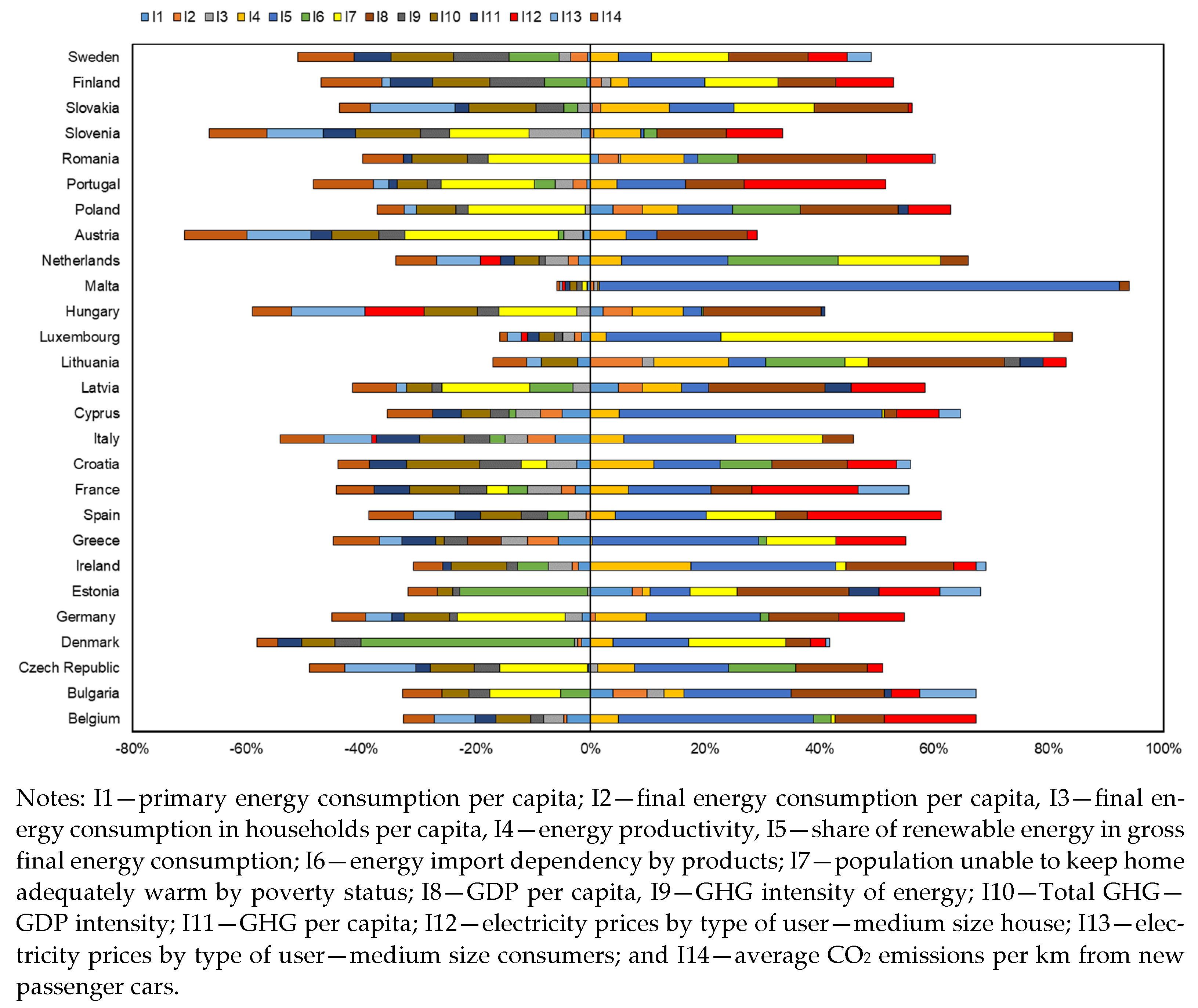
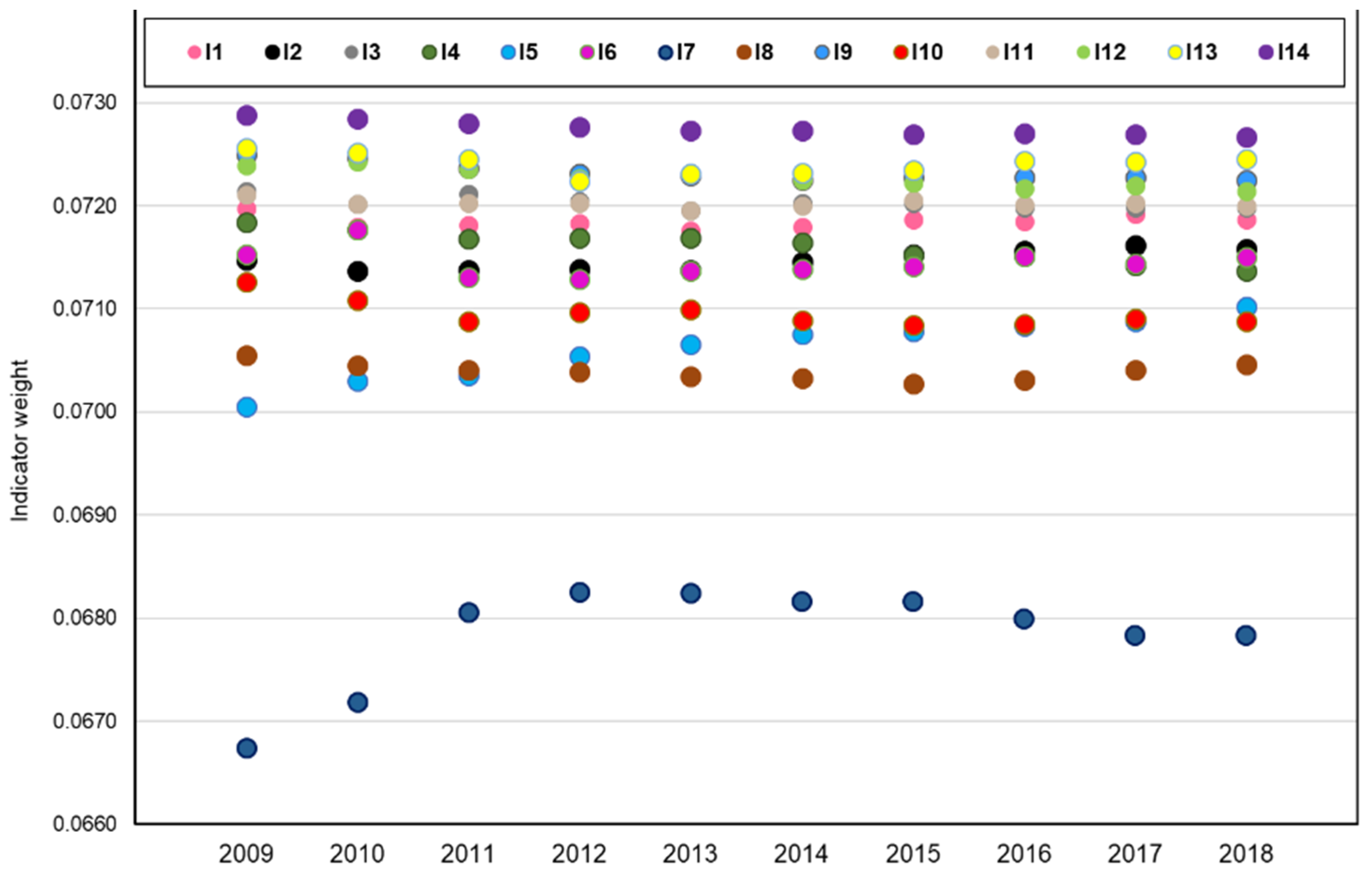
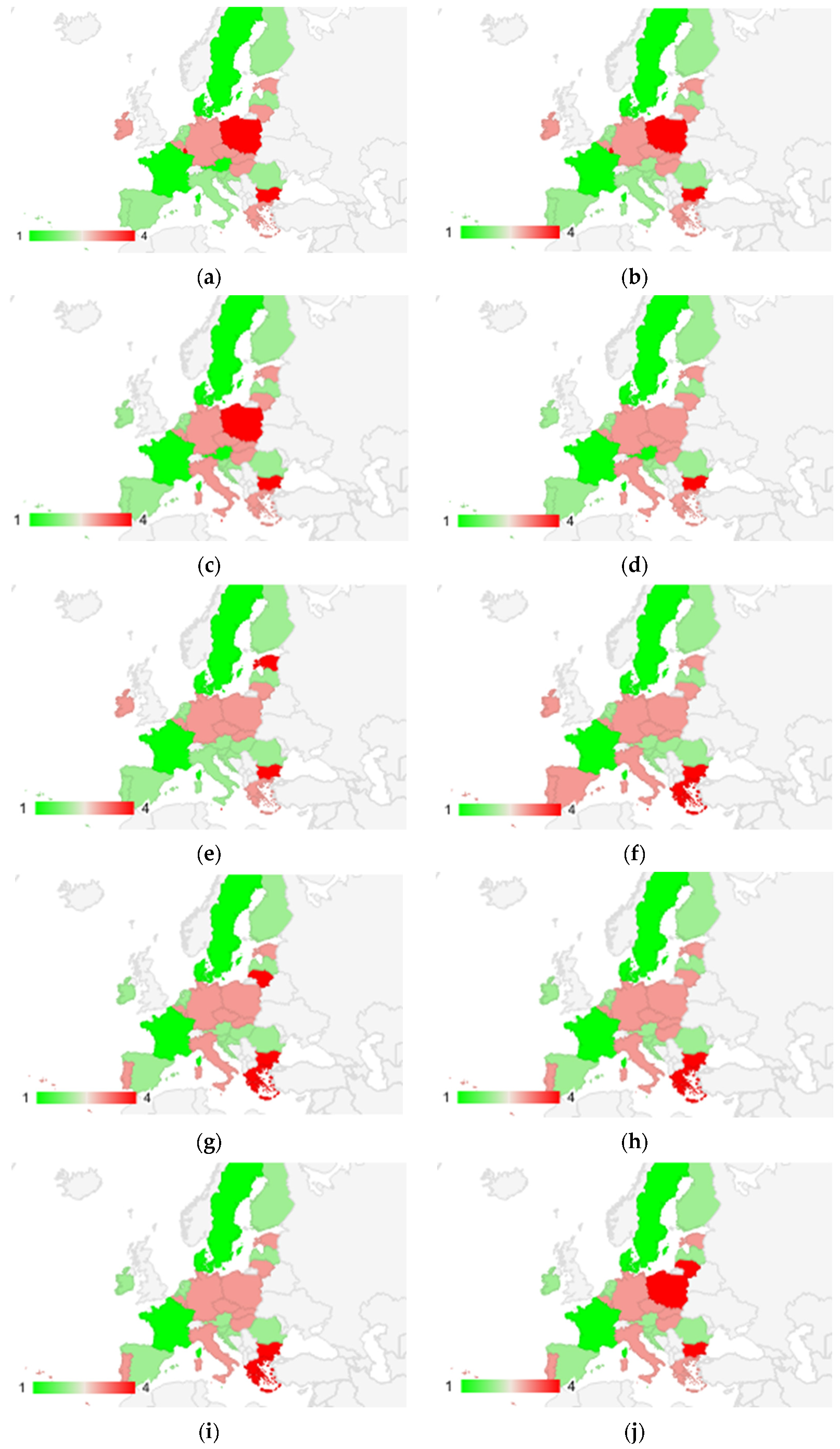
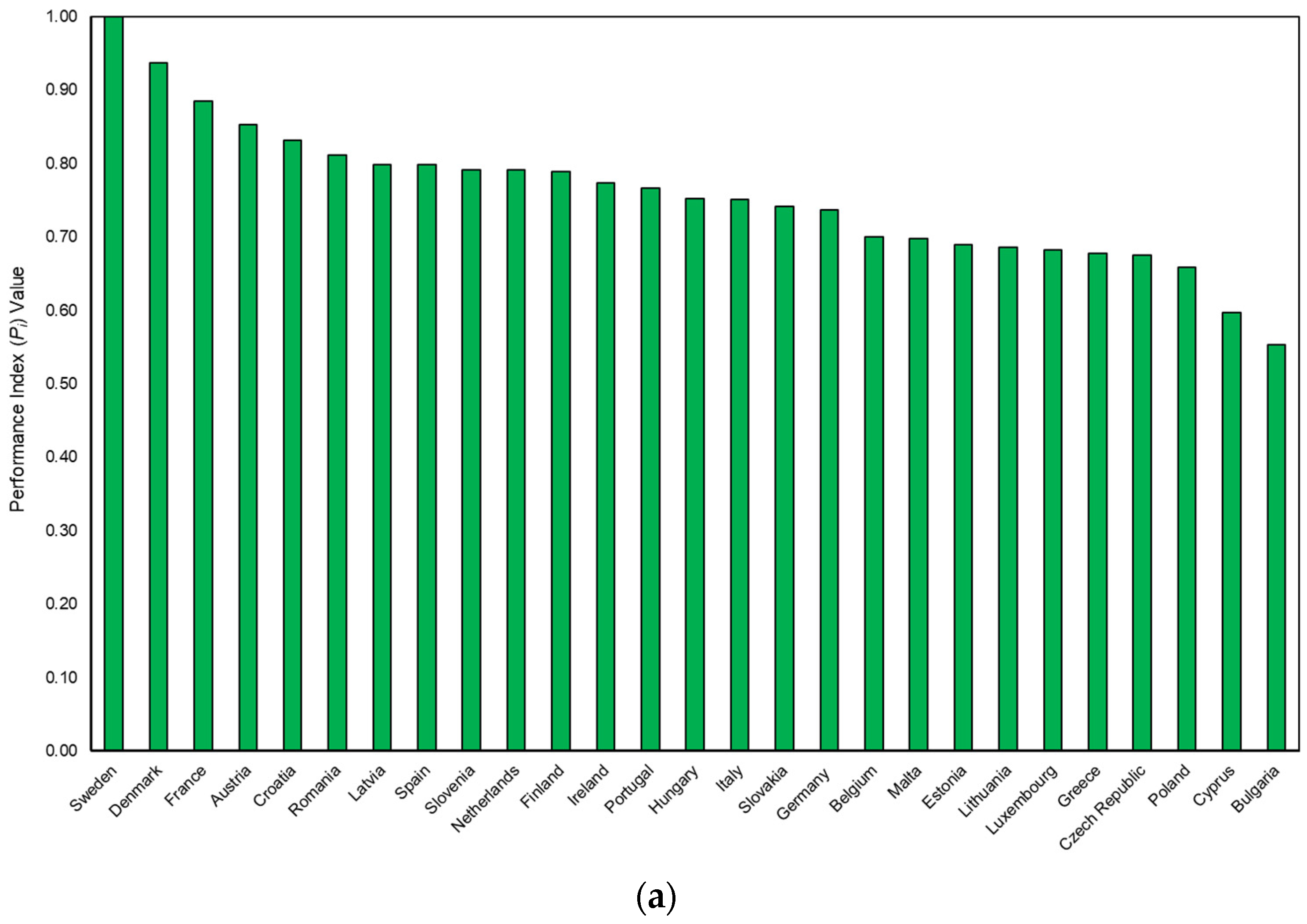
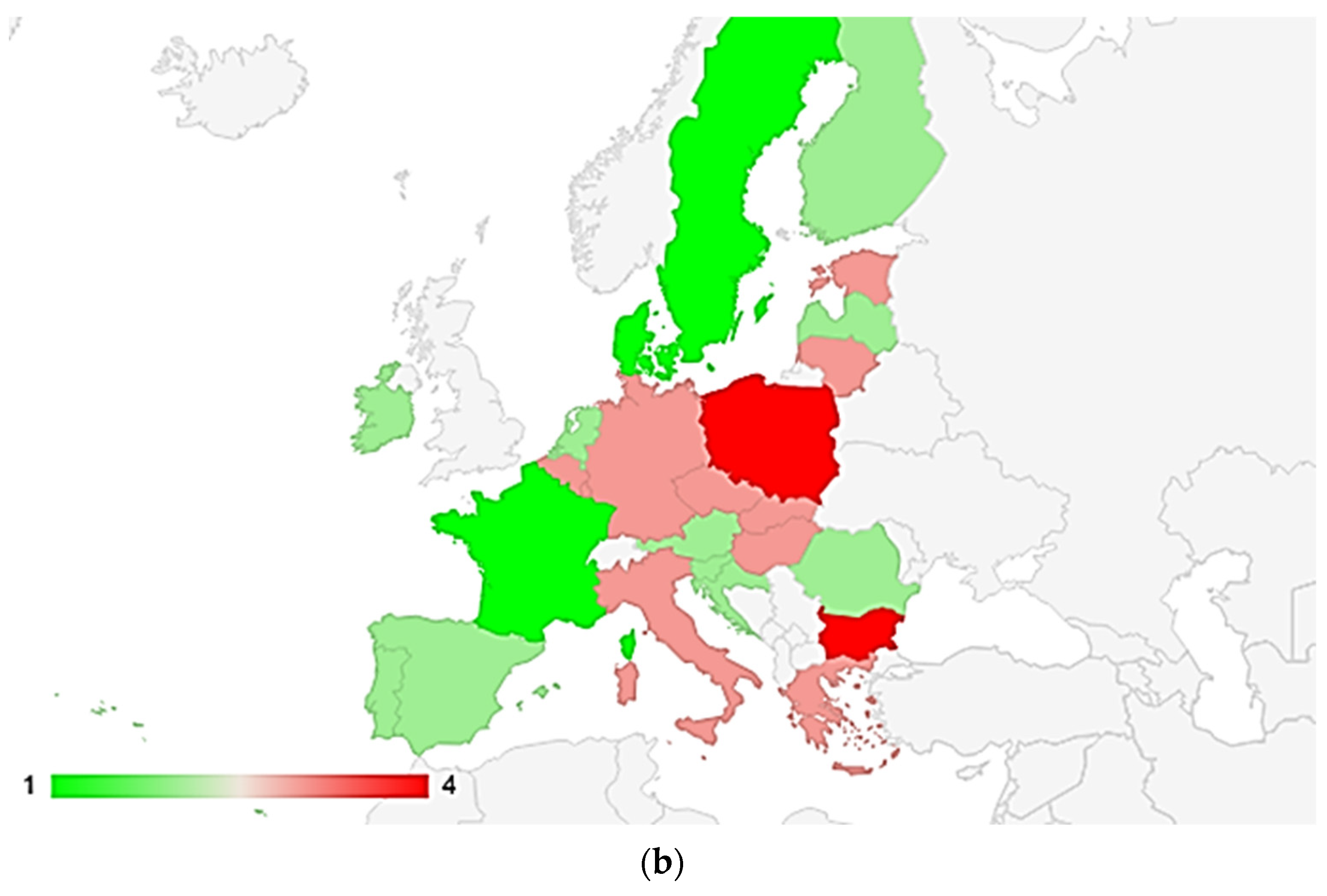
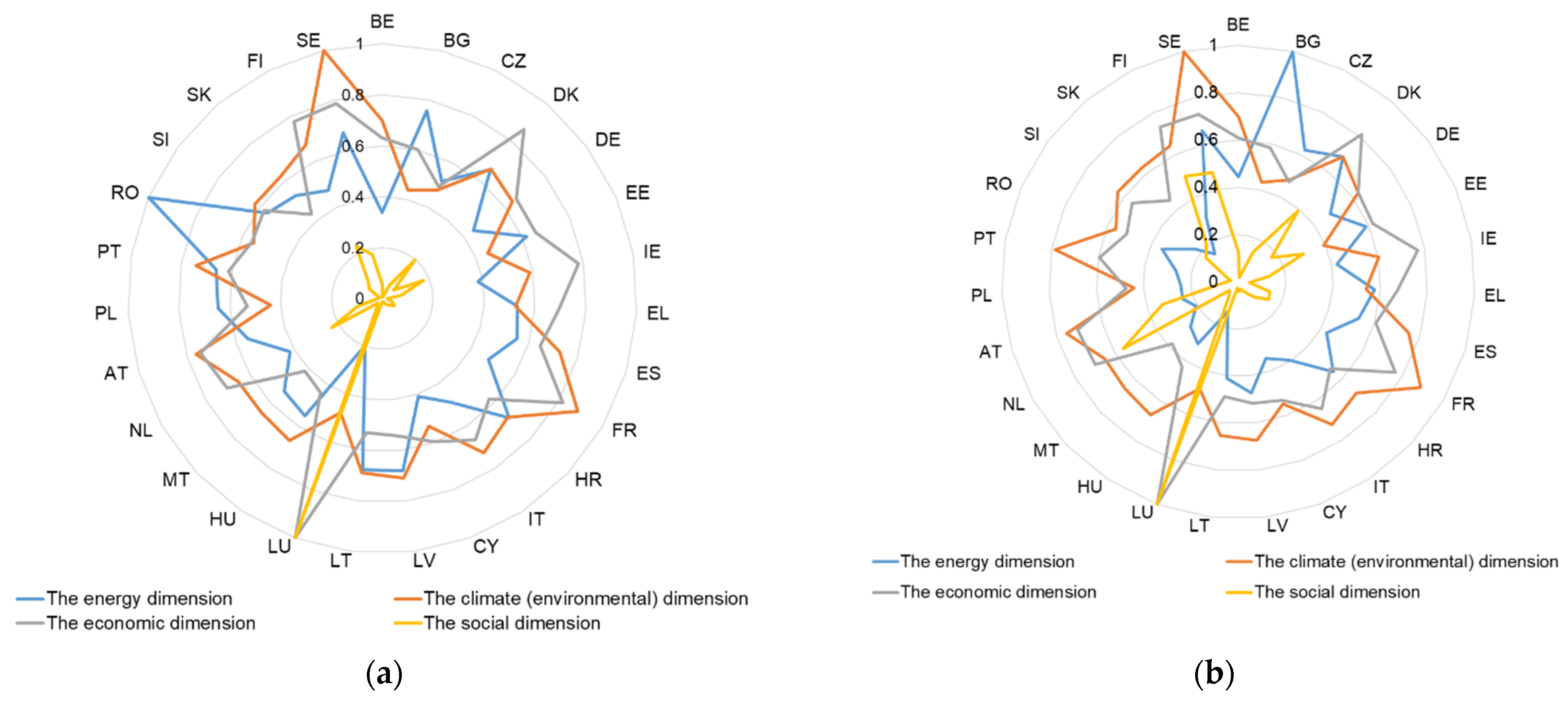
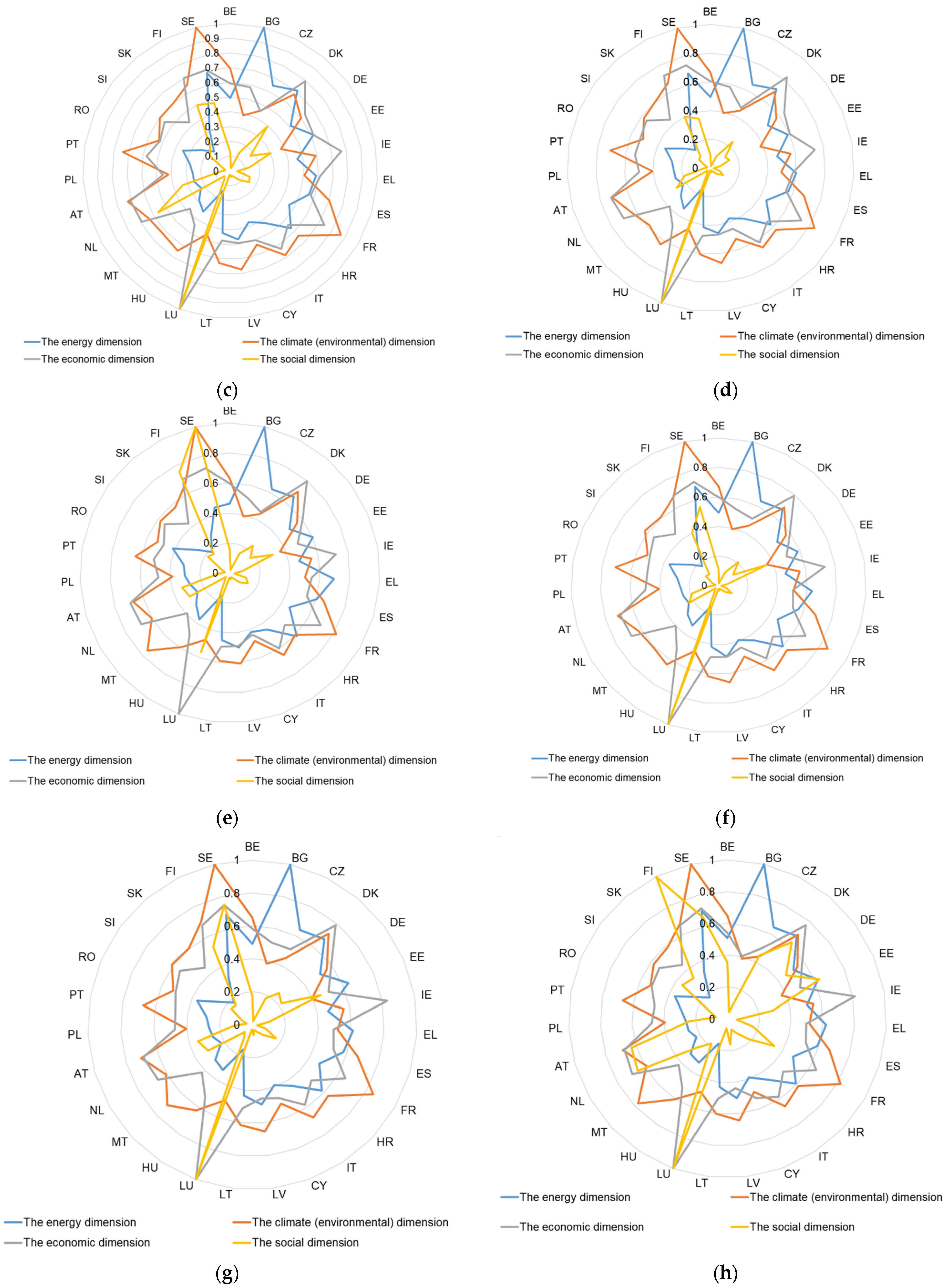

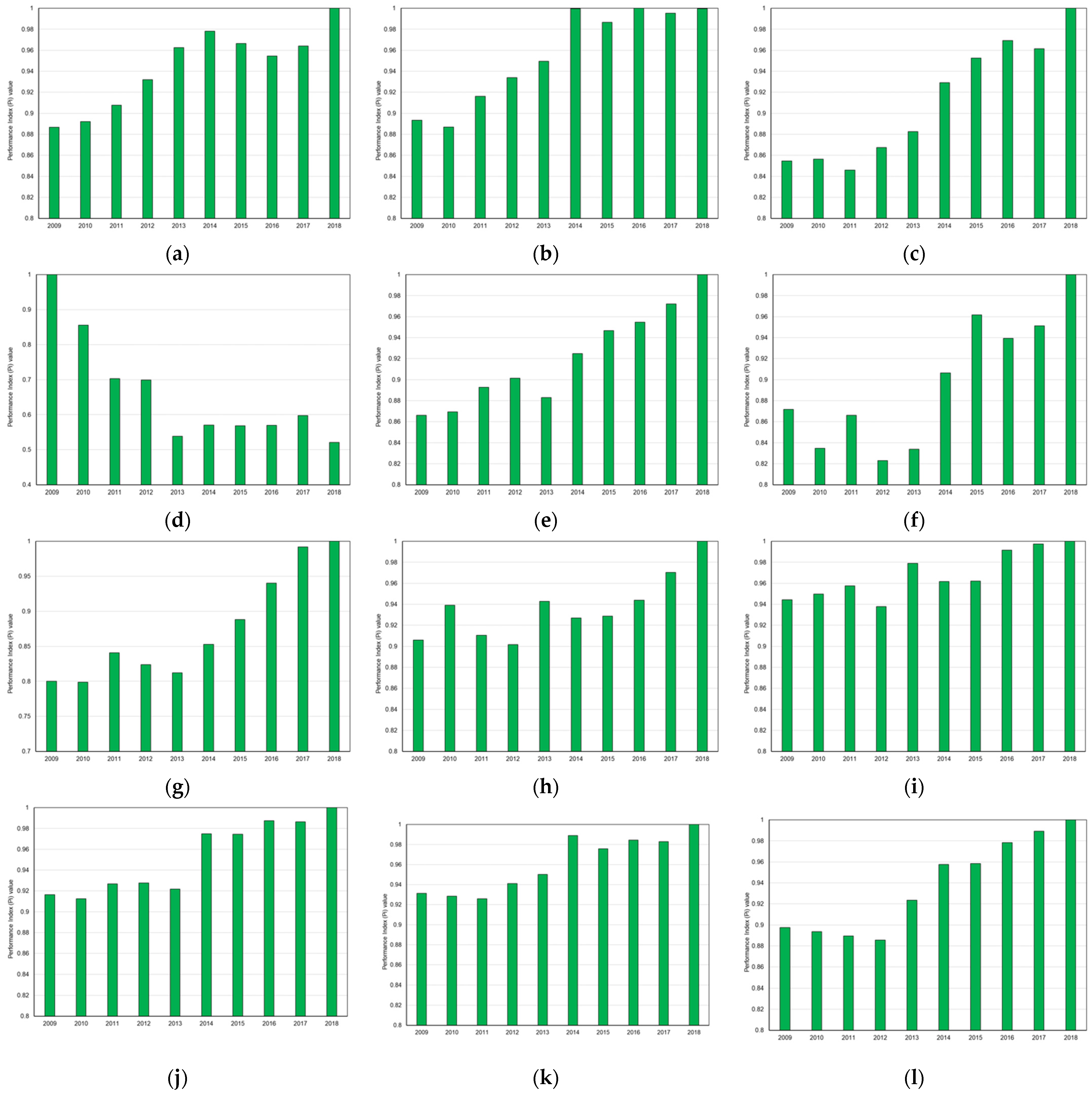
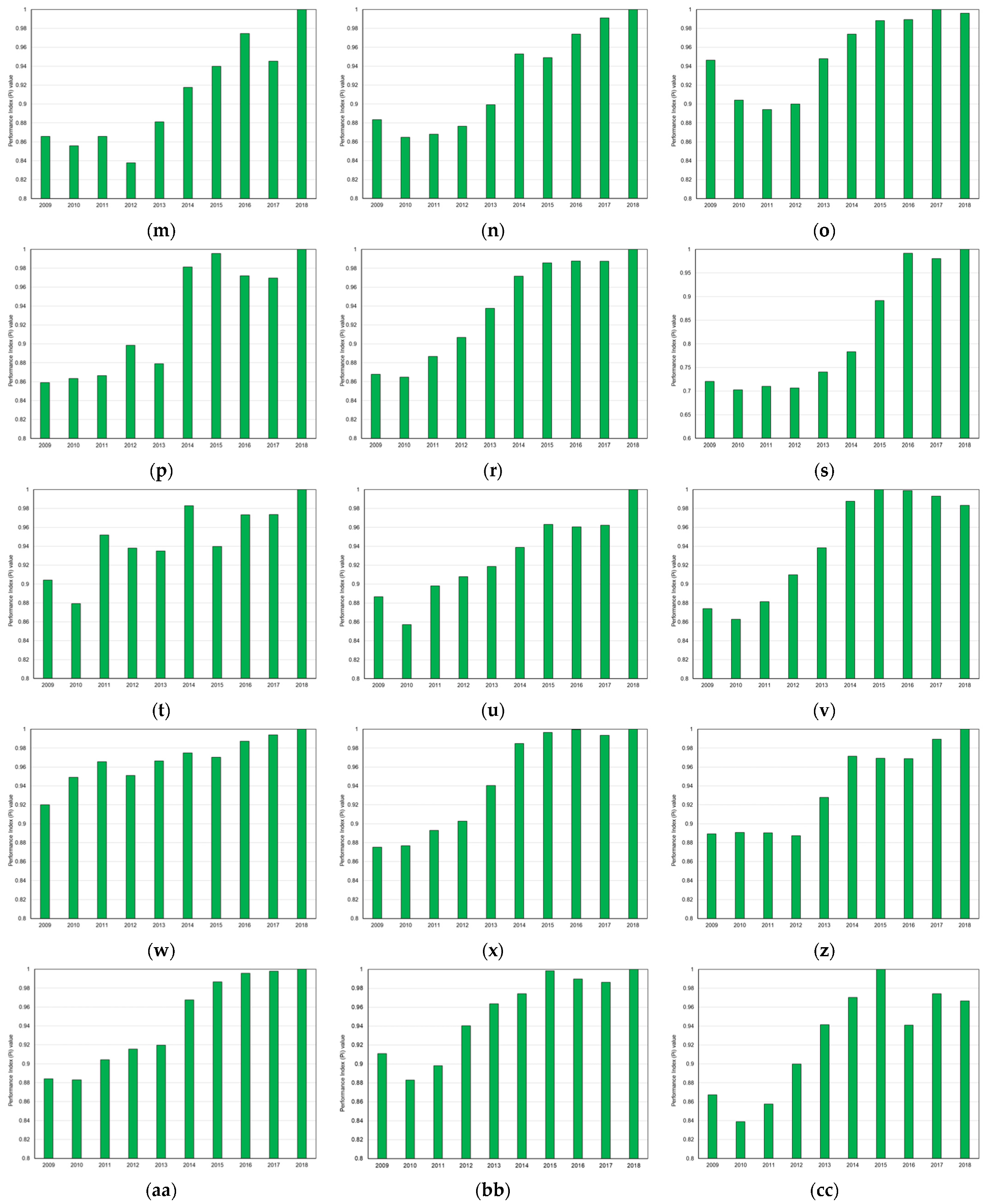
| EU Countries | 2009 | 2010 | 2011 | 2012 | 2013 | 2014 | 2015 | 2016 | 2017 | 2018 | ||||||||||
|---|---|---|---|---|---|---|---|---|---|---|---|---|---|---|---|---|---|---|---|---|
| Pi | R | Pi | R | Pi | R | Pi | R | Pi | R | Pi | R | Pi | R | Pi | R | Pi | R | Pi | R | |
| BE | 0.684 | 21 | 0.707 | 21 | 0.72 | 19 | 0.709 | 18 | 0.701 | 19 | 0.721 | 16 | 0.655 | 19 | 0.688 | 20 | 0.681 | 20 | 0.678 | 22 |
| BG | 0.503 | 27 | 0.535 | 26 | 0.568 | 27 | 0.575 | 26 | 0.589 | 26 | 0.584 | 26 | 0.508 | 27 | 0.544 | 27 | 0.537 | 27 | 0.557 | 27 |
| CZ | 0.657 | 23 | 0.69 | 22 | 0.672 | 23 | 0.668 | 22 | 0.666 | 22 | 0.703 | 19 | 0.649 | 21 | 0.677 | 21 | 0.666 | 21 | 0.687 | 20 |
| DK | 0.947 | 2 | 0.98 | 2 | 0.971 | 2 | 0.987 | 2 | 0.947 | 2 | 0.91 | 2 | 0.872 | 2 | 0.949 | 2 | 0.968 | 2 | 0.941 | 2 |
| DE | 0.737 | 14 | 0.77 | 15 | 0.771 | 14 | 0.752 | 15 | 0.725 | 17 | 0.722 | 15 | 0.668 | 18 | 0.727 | 18 | 0.73 | 18 | 0.743 | 17 |
| EE | 0.736 | 15 | 0.715 | 19 | 0.714 | 20 | 0.691 | 19 | 0.65 | 24 | 0.697 | 20 | 0.654 | 20 | 0.676 | 22 | 0.662 | 23 | 0.68 | 21 |
| IE | 0.734 | 17 | 0.777 | 14 | 0.792 | 12 | 0.761 | 13 | 0.742 | 15 | 0.689 | 21 | 0.746 | 8 | 0.806 | 7 | 0.834 | 4 | 0.841 | 5 |
| EL | 0.709 | 20 | 0.768 | 14 | 0.723 | 18 | 0.683 | 20 | 0.688 | 20 | 0.621 | 24 | 0.605 | 24 | 0.64 | 25 | 0.646 | 25 | 0.663 | 23 |
| ES | 0.818 | 6 | 0.859 | 5 | 0.844 | 6 | 0.808 | 8 | 0.825 | 7 | 0.744 | 13 | 0.721 | 12 | 0.782 | 11 | 0.773 | 13 | 0.774 | 13 |
| FR | 0.893 | 3 | 0.933 | 2 | 0.927 | 3 | 0.898 | 3 | 0.876 | 3 | 0.877 | 3 | 0.826 | 3 | 0.876 | 3 | 0.865 | 3 | 0.873 | 3 |
| HR | 0.841 | 5 | 0.88 | 3 | 0.857 | 5 | 0.848 | 5 | 0.84 | 5 | 0.845 | 4 | 0.75 | 7 | 0.812 | 6 | 0.797 | 8 | 0.805 | 8 |
| IT | 0.763 | 12 | 0.797 | 8 | 0.77 | 15 | 0.745 | 17 | 0.761 | 14 | 0.718 | 17 | 0.678 | 17 | 0.751 | 15 | 0.745 | 15 | 0.751 | 14 |
| CY | 0.612 | 26 | 0.62 | 16 | 0.615 | 26 | 0.571 | 27 | 0.584 | 27 | 0.562 | 27 | 0.568 | 26 | 0.611 | 26 | 0.58 | 26 | 0.602 | 26 |
| LV | 0.795 | 7 | 0.815 | 5 | 0.79 | 13 | 0.781 | 12 | 0.783 | 11 | 0.824 | 7 | 0.726 | 11 | 0.804 | 8 | 0.808 | 7 | 0.816 | 7 |
| LT | 0.734 | 17 | 0.727 | 11 | 0.676 | 21 | 0.673 | 21 | 0.703 | 18 | 0.703 | 19 | 0.577 | 25 | 0.674 | 23 | 0.664 | 22 | 0.652 | 24 |
| LU | 0.634 | 25 | 0.671 | 12 | 0.672 | 23 | 0.664 | 23 | 0.675 | 21 | 0.681 | 23 | 0.69 | 15 | 0.705 | 19 | 0.695 | 19 | 0.7 | 19 |
| HU | 0.718 | 18 | 0.752 | 10 | 0.754 | 16 | 0.753 | 14 | 0.763 | 13 | 0.774 | 11 | 0.709 | 13 | 0.751 | 15 | 0.74 | 17 | 0.747 | 15 |
| MT | 0.668 | 22 | 0.674 | 10 | 0.655 | 25 | 0.628 | 25 | 0.631 | 25 | 0.619 | 25 | 0.632 | 23 | 0.793 | 9 | 0.779 | 10 | 0.792 | 9 |
| NL | 0.771 | 11 | 0.806 | 6 | 0.833 | 7 | 0.81 | 7 | 0.804 | 8 | 0.8 | 10 | 0.738 | 10 | 0.789 | 10 | 0.775 | 12 | 0.789 | 10 |
| AT | 0.861 | 4 | 0.883 | 2 | 0.882 | 4 | 0.872 | 4 | 0.855 | 4 | 0.843 | 5 | 0.786 | 4 | 0.845 | 4 | 0.833 | 5 | 0.851 | 4 |
| PL | 0.636 | 24 | 0.661 | 8 | 0.659 | 24 | 0.659 | 24 | 0.662 | 23 | 0.682 | 22 | 0.641 | 22 | 0.661 | 24 | 0.653 | 24 | 0.647 | 25 |
| PT | 0.76 | 13 | 0.815 | 4 | 0.817 | 9 | 0.783 | 10 | 0.779 | 12 | 0.723 | 14 | 0.704 | 14 | 0.751 | 15 | 0.747 | 14 | 0.746 | 16 |
| RO | 0.772 | 10 | 0.825 | 2 | 0.827 | 8 | 0.819 | 6 | 0.829 | 6 | 0.831 | 6 | 0.752 | 6 | 0.823 | 5 | 0.812 | 6 | 0.816 | 7 |
| SI | 0.78 | 8 | 0.82 | 2 | 0.803 | 10 | 0.782 | 11 | 0.795 | 9 | 0.808 | 9 | 0.744 | 9 | 0.781 | 12 | 0.783 | 9 | 0.784 | 11 |
| SK | 0.71 | 19 | 0.755 | 4 | 0.75 | 17 | 0.747 | 16 | 0.738 | 16 | 0.744 | 13 | 0.681 | 16 | 0.747 | 17 | 0.744 | 16 | 0.74 | 18 |
| FI | 0.779 | 9 | 0.791 | 2 | 0.794 | 11 | 0.789 | 9 | 0.789 | 10 | 0.82 | 8 | 0.764 | 5 | 0.779 | 13 | 0.778 | 11 | 0.775 | 12 |
| SE | 1 | 1 | 1 | 1 | 1 | 1 | 1 | 1 | 1 | 1 | 1 | 1 | 1 | 1 | 1 | 1 | 1 | 1 | 1 | 1 |
| 0.750 | 0.779 | 0.772 | 0.758 | 0.756 | 0.750 | 0.705 | 0.757 | 0.752 | 0.757 | 0.750 | ||||||||||
| 0.104 | 0.106 | 0.104 | 0.107 | 0.101 | 0.101 | 0.099 | 0.098 | 0.103 | 0.098 | 0.104 | ||||||||||
| Year | Class 1 | Class 2 | Class 3 | Class 4 |
|---|---|---|---|---|
| 2009 | Sweden, Denmark, France, Austria | Croatia, Spain, Latvia, Slovenia, Finland, Romania, The Netherlands, Italy, Portugal | Germany, Estonia, Lithuania, Ireland, Hungary, Slovakia, Greece, Belgium, Malta, Czech Republic | Poland, Luxembourg Cyprus, Bulgaria |
| 2010 | Sweden, Denmark, France | Austria, Croatia, Spain, Romania, Slovenia, Portugal, Latvia, The Netherlands, Italy, Finland | Ireland, Germany, Greece, Slovakia, Hungary, Lithuania, Estonia, Belgium, Czech Republic, Malta | Luxembourg, Poland, Cyprus, Bulgaria |
| 2011 | Sweden, Denmark, France, Austria | Croatia, Spain, the Netherlands, Romania, Portugal, Slovenia, Finland, Ireland, Latvia | Germany, Italy, Hungary, Slovakia, Greece, Belgium, Estonia, Lithuania, Luxembourg, Czech Republic | Poland, Malta, Cyprus, Bulgaria |
| 2012 | Sweden, Denmark, France, Austria | Croatia, Romania, The Netherlands, Spain, Finland, Portugal, Slovenia, Latvia, Ireland | Hungary, Germany, Slovakia, Italy, Belgium, Estonia, Greece, Lithuania, Czech Republic, Luxembourg, Poland | Malta, Bulgaria, Cyprus |
| 2013 | Sweden, Denmark, France | Austria, Croatia, Romania, Spain, The Netherlands, Slovenia, Finland, Latvia, Portugal, Hungary, Italy | Ireland, Slovakia, Germany, Lithuania, Belgium, Greece, Luxembourg, Czech Republic, Poland | Estonia, Malta, Bulgaria, Cyprus |
| 2014 | Sweden, Denmark, France | Croatia, Austria, Romania, Latvia, Finland, Slovenia, The Netherlands, Hungary, | Spain, Slovakia, Portugal, Germany, Belgium, Italy, Czech Republic, Lithuania, Estonia, Ireland, Poland, Luxembourg | Greece, Malta, Bulgaria, Cyprus |
| 2015 | Sweden, Denmark, France | Austria, Finland, Romania, Croatia, Ireland, Slovenia, The Netherlands, Latvia, Spain, Hungary | Portugal, Luxembourg, Slovakia, Italy, Germany, Belgium, Estonia, Czech Republic, Poland, Malta | Greece, Lithuania, Cyprus, Bulgaria |
| 2016 | Sweden, Denmark, France | Austria, Romania, Croatia, Ireland, Latvia, Malta, The Netherlands, Spain, Slovenia, Finland | Hungary, Portugal Italy, Slovakia, Germany, Luxembourg, Belgium Czech Republic, Estonia, Lithuania, Poland | Greece, Cyprus, Bulgaria |
| 2017 | Sweden, Denmark, France | Ireland, Austria, Romania, Latvia, Croatia, Slovenia, Malta, Finland, The Netherlands, Spain | Portugal, Italy, Slovakia, Hungary, Germany, Luxembourg, Belgium Czech Republic, Lithuania, Estonia, Poland | Greece, Cyprus, Bulgaria |
| 2018 | Sweden, Denmark, France | Austria, Ireland, Romania, Latvia, Croatia, Malta, The Netherlands, Slovenia, Finland, Spain | Italy, Hungary, Portugal, Germany Slovakia, Luxembourg, Czech Republic, Estonia, Belgium, Greece | Lithuania, Poland, Cyprus, Bulgaria |
| EU Countries | Dimension | 2009 | 2010 | 2011 | 2012 | 2013 | 2014 | 2015 | 2016 | 2017 | 2018 |
|---|---|---|---|---|---|---|---|---|---|---|---|
| Belgium | Energy | 4 | 2 | 2 | 2 | 2 | 2 | 2 | 2 | 2 | 2 |
| Climate | 2 | 2 | 2 | 2 | 2 | 2 | 2 | 2 | 2 | 2 | |
| Economic | 3 | 4 | 3 | 2 | 2 | 2 | 2 | 3 | 3 | 3 | |
| Social | 2 | 3 | 3 | 3 | 2 | 2 | 3 | 2 | 3 | 3 | |
| Bulgaria | Energy | 1 | 1 | 1 | 1 | 1 | 1 | 1 | 1 | 1 | 1 |
| Climate | 4 | 4 | 4 | 4 | 4 | 4 | 4 | 4 | 4 | 4 | |
| Economic | 3 | 3 | 3 | 3 | 3 | 3 | 3 | 4 | 4 | 3 | |
| Social | 4 | 4 | 4 | 4 | 4 | 4 | 4 | 4 | 4 | 4 | |
| Czech Republic | Energy | 3 | 1 | 1 | 1 | 2 | 1 | 1 | 1 | 2 | 2 |
| Climate | 4 | 3 | 4 | 4 | 4 | 4 | 4 | 4 | 4 | 4 | |
| Economic | 4 | 4 | 4 | 3 | 3 | 3 | 3 | 3 | 3 | 3 | |
| Social | 3 | 3 | 3 | 3 | 3 | 3 | 3 | 3 | 3 | 2 | |
| Denmark | Energy | 2 | 1 | 1 | 1 | 1 | 1 | 1 | 1 | 1 | 1 |
| Climate | 2 | 2 | 2 | 2 | 2 | 2 | 2 | 2 | 2 | 2 | |
| Economic | 1 | 1 | 1 | 1 | 1 | 1 | 1 | 1 | 1 | 1 | |
| Social | 1 | 2 | 2 | 2 | 2 | 2 | 2 | 1 | 2 | 2 | |
| Germany | Energy | 3 | 2 | 2 | 2 | 2 | 2 | 2 | 2 | 2 | 2 |
| Climate | 3 | 3 | 3 | 3 | 3 | 3 | 3 | 3 | 3 | 3 | |
| Economic | 2 | 2 | 2 | 2 | 2 | 2 | 2 | 2 | 2 | 2 | |
| Social | 3 | 2 | 2 | 2 | 2 | 2 | 2 | 3 | 3 | 2 | |
| Estonia | Energy | 2 | 2 | 2 | 2 | 2 | 2 | 2 | 2 | 2 | 2 |
| Climate | 4 | 4 | 4 | 4 | 4 | 4 | 4 | 4 | 4 | 4 | |
| Economic | 3 | 2 | 2 | 2 | 3 | 3 | 3 | 1 | 3 | 3 | |
| Social | 2 | 2 | 2 | 2 | 2 | 2 | 1 | 1 | 3 | 1 | |
| Ireland | Energy | 4 | 2 | 2 | 2 | 2 | 2 | 2 | 2 | 2 | 2 |
| Climate | 3 | 3 | 3 | 3 | 3 | 3 | 3 | 3 | 3 | 3 | |
| Economic | 4 | 1 | 1 | 1 | 1 | 1 | 1 | 3 | 1 | 1 | |
| Social | 2 | 3 | 3 | 3 | 3 | 3 | 3 | 3 | 3 | 3 | |
| Greece | Energy | 3 | 2 | 2 | 2 | 1 | 1 | 2 | 2 | 2 | 1 |
| Climate | 3 | 3 | 3 | 3 | 3 | 3 | 3 | 3 | 3 | 3 | |
| Economic | 2 | 2 | 2 | 3 | 3 | 3 | 3 | 3 | 3 | 3 | |
| Social | 3 | 4 | 3 | 4 | 4 | 4 | 4 | 4 | 4 | 4 | |
| Spain | Energy | 3 | 2 | 2 | 2 | 2 | 2 | 2 | 2 | 2 | 2 |
| Climate | 2 | 1 | 2 | 2 | 2 | 2 | 2 | 2 | 2 | 2 | |
| Economic | 2 | 3 | 3 | 3 | 3 | 3 | 3 | 3 | 3 | 3 | |
| Social | 3 | 3 | 3 | 3 | 3 | 3 | 3 | 3 | 3 | 3 | |
| France | Energy | 3 | 2 | 2 | 2 | 2 | 2 | 2 | 2 | 2 | 2 |
| Climate | 1 | 1 | 1 | 1 | 1 | 1 | 1 | 1 | 1 | 1 | |
| Economic | 1 | 1 | 1 | 2 | 2 | 2 | 2 | 2 | 2 | 2 | |
| Social | 3 | 3 | 3 | 3 | 3 | 3 | 3 | 3 | 3 | 3 | |
| Croatia | Energy | 2 | 2 | 2 | 2 | 2 | 2 | 2 | 2 | 2 | 2 |
| Climate | 2 | 2 | 2 | 2 | 2 | 2 | 2 | 2 | 2 | 2 | |
| Economic | 3 | 3 | 3 | 3 | 3 | 3 | 3 | 3 | 3 | 3 | |
| Social | 3 | 3 | 3 | 3 | 3 | 3 | 3 | 3 | 3 | 3 | |
| Italy | Energy | 3 | 3 | 3 | 3 | 2 | 2 | 3 | 2 | 2 | 2 |
| Climate | 2 | 2 | 2 | 2 | 2 | 2 | 2 | 2 | 2 | 2 | |
| Economic | 2 | 2 | 2 | 2 | 2 | 2 | 2 | 2 | 2 | 2 | |
| Social | 3 | 3 | 3 | 4 | 4 | 4 | 3 | 3 | 3 | 3 | |
| Cyprus | Energy | 4 | 3 | 3 | 3 | 3 | 3 | 3 | 3 | 3 | 3 |
| Climate | 3 | 3 | 3 | 3 | 3 | 3 | 3 | 3 | 3 | 3 | |
| Economic | 3 | 3 | 3 | 4 | 4 | 4 | 3 | 3 | 4 | 3 | |
| Social | 3 | 4 | 4 | 4 | 4 | 4 | 4 | 4 | 4 | 4 | |
| Latvia | Energy | 2 | 2 | 2 | 2 | 2 | 2 | 2 | 2 | 2 | 2 |
| Climate | 2 | 2 | 2 | 2 | 2 | 2 | 2 | 2 | 2 | 2 | |
| Economic | 3 | 3 | 3 | 3 | 3 | 3 | 3 | 4 | 4 | 3 | |
| Social | 3 | 4 | 3 | 4 | 4 | 4 | 3 | 3 | 3 | 3 | |
| Lithuania | Energy | 2 | 3 | 3 | 3 | 2 | 3 | 3 | 3 | 3 | 3 |
| Climate | 2 | 2 | 2 | 2 | 3 | 2 | 2 | 2 | 2 | 2 | |
| Economic | 3 | 3 | 3 | 3 | 3 | 3 | 3 | 3 | 3 | 3 | |
| Social | 3 | 4 | 4 | 4 | 4 | 4 | 4 | 4 | 4 | 4 | |
| Luxembourg | Energy | 4 | 4 | 4 | 4 | 4 | 4 | 4 | 4 | 4 | 4 |
| Climate | 4 | 3 | 4 | 4 | 3 | 4 | 3 | 3 | 3 | 3 | |
| Economic | 1 | 1 | 1 | 1 | 1 | 1 | 1 | 1 | 1 | 1 | |
| Social | 1 | 1 | 1 | 1 | 1 | 1 | 1 | 1 | 1 | 1 | |
| Hungary | Energy | 3 | 3 | 3 | 3 | 3 | 3 | 3 | 3 | 3 | 3 |
| Climate | 2 | 2 | 2 | 2 | 3 | 2 | 2 | 2 | 3 | 2 | |
| Economic | 4 | 4 | 4 | 3 | 3 | 3 | 3 | 3 | 3 | 3 | |
| Social | 3 | 3 | 3 | 3 | 3 | 3 | 3 | 3 | 3 | 3 | |
| Malta | Energy | 3 | 3 | 3 | 3 | 3 | 3 | 3 | 3 | 3 | 3 |
| Climate | 2 | 2 | 2 | 3 | 1 | 3 | 2 | 1 | 1 | 1 | |
| Economic | 4 | 4 | 4 | 4 | 4 | 4 | 4 | 4 | 4 | 4 | |
| Social | 3 | 3 | 3 | 4 | 4 | 4 | 3 | 3 | 3 | 3 | |
| The Netherlands | Energy | 3 | 4 | 4 | 4 | 4 | 4 | 4 | 4 | 4 | 4 |
| Climate | 2 | 2 | 2 | 2 | 2 | 2 | 3 | 3 | 3 | 2 | |
| Economic | 2 | 2 | 2 | 2 | 2 | 2 | 2 | 2 | 2 | 2 | |
| Social | 1 | 1 | 1 | 2 | 2 | 2 | 2 | 1 | 1 | 1 | |
| Austria | Energy | 3 | 3 | 3 | 3 | 3 | 4 | 4 | 4 | 4 | 3 |
| Climate | 2 | 1 | 2 | 2 | 2 | 2 | 2 | 2 | 2 | 2 | |
| Economic | 2 | 2 | 2 | 2 | 2 | 2 | 2 | 2 | 2 | 2 | |
| Social | 2 | 2 | 2 | 2 | 2 | 2 | 2 | 1 | 1 | 1 | |
| Poland | Energy | 2 | 3 | 3 | 3 | 3 | 3 | 3 | 3 | 4 | 4 |
| Climate | 4 | 4 | 4 | 4 | 4 | 4 | 4 | 4 | 4 | 4 | |
| Economic | 3 | 4 | 4 | 3 | 3 | 3 | 3 | 3 | 3 | 3 | |
| Social | 3 | 3 | 3 | 3 | 3 | 3 | 3 | 3 | 3 | 3 | |
| Portugal | Energy | 2 | 3 | 3 | 3 | 3 | 3 | 3 | 3 | 3 | 3 |
| Climate | 2 | 1 | 2 | 2 | 2 | 2 | 2 | 2 | 2 | 2 | |
| Economic | 3 | 3 | 3 | 3 | 3 | 3 | 3 | 3 | 3 | 3 | |
| Social | 3 | 4 | 4 | 4 | 4 | 4 | 4 | 4 | 4 | 4 | |
| Romania | Energy | 1 | 3 | 3 | 3 | 3 | 3 | 3 | 3 | 3 | 3 |
| Climate | 3 | 3 | 3 | 3 | 3 | 3 | 3 | 3 | 3 | 3 | |
| Economic | 3 | 3 | 3 | 3 | 3 | 3 | 3 | 3 | 3 | 3 | |
| Social | 3 | 3 | 3 | 3 | 3 | 4 | 3 | 3 | 3 | 3 | |
| Slovenia | Energy | 2 | 3 | 4 | 4 | 4 | 4 | 4 | 4 | 4 | 4 |
| Climate | 3 | 2 | 3 | 3 | 3 | 2 | 2 | 3 | 3 | 3 | |
| Economic | 3 | 3 | 3 | 3 | 3 | 3 | 3 | 3 | 3 | 3 | |
| Social | 3 | 3 | 2 | 3 | 2 | 3 | 3 | 2 | 2 | 2 | |
| Slovakia | Energy | 3 | 4 | 4 | 4 | 4 | 4 | 4 | 4 | 4 | 4 |
| Climate | 3 | 3 | 3 | 3 | 3 | 3 | 3 | 3 | 3 | 3 | |
| Economic | 4 | 4 | 4 | 4 | 4 | 3 | 3 | 3 | 3 | 3 | |
| Social | 2 | 2 | 2 | 2 | 2 | 3 | 3 | 3 | 2 | 3 | |
| Finland | Energy | 3 | 3 | 3 | 3 | 3 | 3 | 3 | 3 | 3 | 3 |
| Climate | 2 | 2 | 2 | 2 | 2 | 2 | 2 | 2 | 2 | 2 | |
| Economic | 2 | 2 | 2 | 2 | 2 | 2 | 2 | 2 | 2 | 2 | |
| Social | 1 | 1 | 1 | 1 | 1 | 1 | 1 | 1 | 1 | 1 | |
| Sweden | Energy | 2 | 1 | 1 | 1 | 2 | 1 | 1 | 1 | 1 | 1 |
| Climate | 1 | 1 | 1 | 1 | 1 | 1 | 1 | 1 | 1 | 1 | |
| Economic | 1 | 2 | 2 | 2 | 1 | 1 | 1 | 1 | 2 | 2 | |
| Social | 1 | 1 | 1 | 1 | 1 | 1 | 1 | 1 | 1 | 1 |
Publisher’s Note: MDPI stays neutral with regard to jurisdictional claims in published maps and institutional affiliations. |
© 2021 by the authors. Licensee MDPI, Basel, Switzerland. This article is an open access article distributed under the terms and conditions of the Creative Commons Attribution (CC BY) license (http://creativecommons.org/licenses/by/4.0/).
Share and Cite
Tutak, M.; Brodny, J.; Bindzár, P. Assessing the Level of Energy and Climate Sustainability in the European Union Countries in the Context of the European Green Deal Strategy and Agenda 2030. Energies 2021, 14, 1767. https://doi.org/10.3390/en14061767
Tutak M, Brodny J, Bindzár P. Assessing the Level of Energy and Climate Sustainability in the European Union Countries in the Context of the European Green Deal Strategy and Agenda 2030. Energies. 2021; 14(6):1767. https://doi.org/10.3390/en14061767
Chicago/Turabian StyleTutak, Magdalena, Jarosław Brodny, and Peter Bindzár. 2021. "Assessing the Level of Energy and Climate Sustainability in the European Union Countries in the Context of the European Green Deal Strategy and Agenda 2030" Energies 14, no. 6: 1767. https://doi.org/10.3390/en14061767
APA StyleTutak, M., Brodny, J., & Bindzár, P. (2021). Assessing the Level of Energy and Climate Sustainability in the European Union Countries in the Context of the European Green Deal Strategy and Agenda 2030. Energies, 14(6), 1767. https://doi.org/10.3390/en14061767







